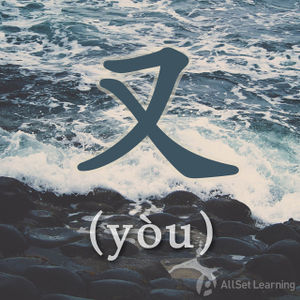Difference between revisions of "Expressing "both A and B" with "you""
m (Text replacement - ". </span>" to ".</span>") |
|||
| (2 intermediate revisions by 2 users not shown) | |||
| Line 41: | Line 41: | ||
=== Books === | === Books === | ||
| − | + | {{Source|HSK Standard Course 3|32}} | |
| − | + | {{Source|Integrated Chinese: Level 1, Part 2 (3rd ed)|122}} | |
| − | + | {{Source|Integrated Chinese: Level 2, Part 1|87}} | |
| + | {{Source|New Practical Chinese Reader 3 (新实用汉语课本3)|66}} | ||
[[Category:A2 grammar points]] | [[Category:A2 grammar points]] | ||
| + | {{HSK|HSK3}} | ||
{{Basic Grammar|又|A2|又⋯⋯ 又⋯⋯|他 <em>又</em> 高 <em>又</em> 帅。|grammar point|ASGPFUM2}} | {{Basic Grammar|又|A2|又⋯⋯ 又⋯⋯|他 <em>又</em> 高 <em>又</em> 帅。|grammar point|ASGPFUM2}} | ||
{{Rel char|又}} | {{Rel char|又}} | ||
| Line 52: | Line 54: | ||
{{Similar|"Both… and…" with "ji"}} | {{Similar|"Both… and…" with "ji"}} | ||
{{Similar|Simple "noun + adjective" sentences}} | {{Similar|Simple "noun + adjective" sentences}} | ||
| + | {{Similar|Repeated actions in the past with "you"}} | ||
{{POS|Adverbs with Adjectives}} | {{POS|Adverbs with Adjectives}} | ||
{{Used for| Expressing quality}} | {{Used for| Expressing quality}} | ||
Latest revision as of 01:54, 10 November 2020
-
Level
-
Similar to
-
Used for
-
Keywords
When you're getting descriptive, you may find yourself wanting to use multiple adjectives at a time. The character 又 (yòu) can be used to give two qualities to something. Using the double 又 (yòu) structure is like saying that something is "both… and…" in English.
Structure
The structure in Chinese is:
Subj. + 又 + Adj. 1 + 又 + Adj. 2
The two words shouldn't contrast in feeling. It is important to note they must both be bad or both be good.
Examples
- 她 男朋友 又 高 又 帅。Her boyfriend is both tall and handsome.
- 这 个 房子 又 大 又 亮。This house is both big and bright.
- 妈妈 的 头发 又 黑 又 亮。Mom's hair is both black and shiny.
- 我 姐姐 又 聪明 又 漂亮。My older sister is both smart and beautiful.
- 中国 菜 又 便宜 又 好吃。Chinese food is both cheap and good-tasting.
- 你们 老板 又 年轻 又 有钱。Your boss is both young and rich.
- 这里 的 咖啡 又 贵 又 难喝。The coffee here is both expensive and bad-tasting.
- 我 家 小狗 又 可爱 又 听话。My family's dog is both cute and obedient.
- 上海 的 冬天 又 冷 又 湿。Winter here in Shanghai is both cold and humid.
- 她 小时候 又 矮 又 瘦。She was both short and thin when she was young.



